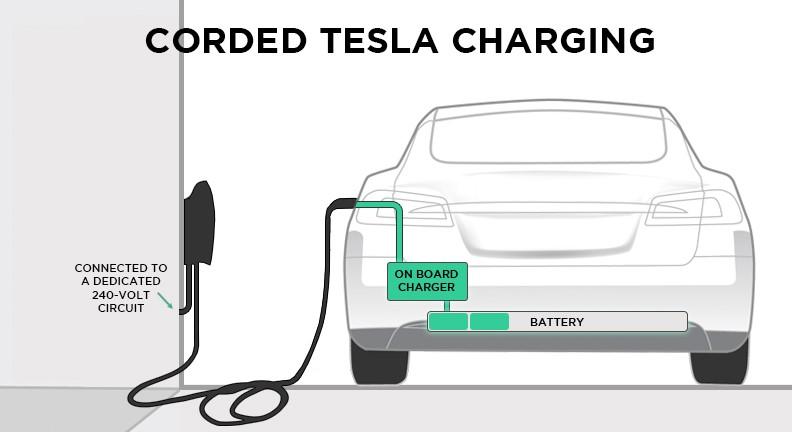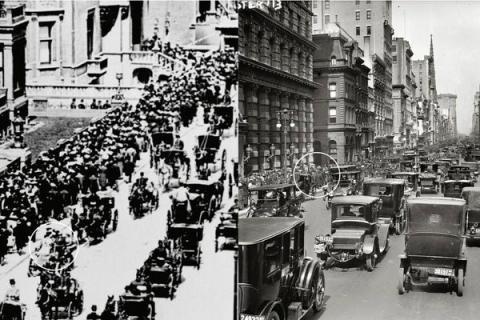You’re not alone. Most electric vehicle (EV) buyers focus on the most expensive (and arguably most exciting!) part of the purchase, the vehicle. This is because in the past, when you purchased or leased a vehicle, the way it was refueled was managed by another company. And when you purchase your shiny new EV, buyers go home thinking the most convenient way to recharge a car is with a standard 8amp socket. So people focus only on the vehicle, and worry about how it will be charged after they have made the purchase. Fleet buyers are generally no different. In this article, I will set out for you the reasons why you should consider dedicated EV charging infrastructure that is more advanced than a standard 8amp socket, and what you should look for in the market.
To get your head around EV charging, the diagram above highlights the 3 parts of an EV charging process for AC charging:
- The wall socket or dedicated Wallbox charger
- The cable
- The on-board AC charger in the car
For EV charging, the weakest part of this 3-way chain determines how fast you can fill your car. An easy analogy is the way you fill your car today. If the pump was slow, then your car would fill up slowly. If the pump hose was small then it would fill up slowly. And if your cars fuel nozzle was small, you’d only be able car would fill up slowly (if not messily!). For EV’s it’s the same, except either the car or the charger determines how fast it can be filled and it’s all done automatically – no liquid fuel spilt on your shoes!
So you could have a 22kW charger, an 11kW rated cable, and a 7.2kW on-board AC charger and the car will only fill up at 7.2kW/hour.
In terms of DC, that’s different because the DC energy goes straight into the battery, bypassing the AC invertor and these are dedicated stations with high rated cables. For the purpose of simplicity, we’ll focus on AC charging in this article, which is the predominate way you will fill your vehicles.
Like anything to do with electricity, there is math involved. The easiest way to work out how fast your car will fill up is to divide the batteries capacity i.e. 30kW, by the weakest part of the chain. So if you have plugged the car into an 8am socket which produces 1.8kW ((8amps x 230volts)/1000 = 1.84kWh), it will take just over 16 hours to fill from empty. As the title says, this can be confusing. The easiest way to approach this is to go for the largest capacity charger you can afford, matched with a cable that has a higher rating than the car, then the car will be the weakest point. Then when you upgrade the fleet in the future you won’t have to upgrade the chargers saving you over the long term.
So there are a few major considerations when thinking about EV charging infrastructure:
Worksafe Compliance. EV charging infrastructure has clear and dedicated Worksafe compliance requirements, and installing equipment which does not comply could have serious consequences. As I always say, electricity is a product best not experienced directly. A Supplier Declaration of Compliance (SDoC) is a minimum, but it can also pay to check with Worksafe directly if you have concerns.
Cost. The cost of charging systems available in NZ varies from just under $1,000 for a cheap AC charger, to more than $50,000 + installation for a DC charger. Like everything in life, you get what you pay for. Higher quality products come with longer warranties (up to 5 years), while cheaper units may be 12 months or less. When it comes to high capacity chargers required to power a car you want to rely on a quality product that won’t break down over time and potentially expose you, your staff, or the public to a product best never experienced directly.
Charging Speed. An 8amp socket can only charge your EV at the rate of 1.8kW/hour. If you have the latest eGolf for example, it would take ~20 hours from empty to fill it up. A dedicated AC charger with at least the ability to meet the eGolf’s on-board AC charger could speed this up to 5 hours, or 44km/hour charging. And if you have a fleet of vehicles that has short turn around cycles you may need to consider including a DC charger in your EV charging infrastructure.
Purpose. Is your charger going to be just for your staff in a private are, or will the public have access to it? If the charger is just going to be for fleet vehicles, in a locked place and no members of the public will use it then you can get away with less features, or even aa charger with a cable attached (tethered). If the charger will be a public place then I argue you need to consider the ability to monetize it in the future, even if you just want a point of difference today. This requires communications capability (Open Charge Point Protocol - OCPP compliance) , an MID certified electricity meter, user identification (RFID or Near Field Contact – NFC) and a software platform to manage payments/access etc.
Quality. EV charging infrastructure needs to be able to handle the harsh NZ sun, and to be able to deal with multiple uses, and for cables to be run over with no fear of damage for years. There are plenty of cheap options on the market, but no-one regrets buying quality.
Tethered vs Untethered. The current European standard for the socket that goes into the vehicle and in the Wallbox is Type 2. The most common car in NZ however is a used Nissan Leaf, which is a generally a Type 1 car port. And who knows where the Type standard may go in the future. I generally recommend customers go with a Type 2 untethered (no cable) Wallbox and a separate cable (or a customer brings their own cable – BYoC). If the Type changes you can always get a new cable, a much more economic option. It also means staff or customers can charge older vehicles with the appropriate cable.
Local Energy Constraints (real or financial). This usually pricks the ears of either the CFO, or for those company’s large enough to have one, the energy manager. Some businesses have physical energy constraints (limits to the amount of electricity a site can consume due to weak infrastructure – transformers and/or lines), or financial capacity constraints (limits that if exceeded increase the electricity cost for all electricity consumed). Intelligent EV charging infrastructure can manage this for you across multiple charging stations. Basic chargers operate in a ‘dumb’ fashion, just drawing as much energy as they can, even if this means popping fuses. If in doubt, go with smart!
Access. Believe it or not but fights have broken out in parts of the world over EV car parks. This has occurred when traditional petrol/diesel cars have parked in EV designated carparks, and when EV drivers have left cars parked that are clearly full. So it is important to both clearly label the parks as EV charging parks (perhaps exclusively) and to share EV charging etiquette guidelines to staff and even customers.
I still get asked at barbeques “do you think we will see EV’s on the road in any great numbers in our lifetime?”. The two pictures below are 5th Avenue New York 13 -years apart (1900 versus 1913). In the first photo you struggle to find a car. In the second you struggle to find a horse. Technology speed is very different today than it was in 1900. Fossil fueled vehicles are the horse of the 1900’s (actually I could argue that cars driven by people are the horse of the 1900’s, but that’s a discussion for another time!).
If this short article hasn’t shed some light on this rather confusing space, please feel free to contact me directly. We’d be happy to help.
Nigel Broomhall




